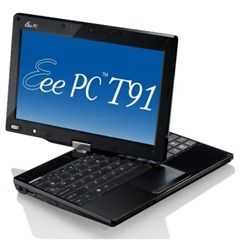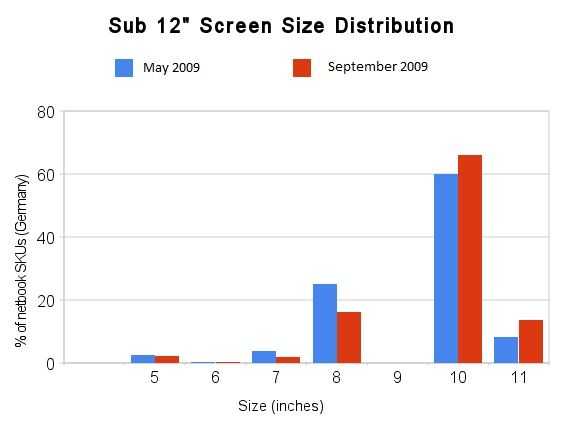Back in May, I took a look at the small notebook PC market to try and determine the distribution of screen sizes. I took screen sizes of 11 inch and under and plotted them on a graph to find the unsurprising result that the 10 inch screen size was the most popular and the original 7 inch netbook had all but died. In May 2009, 68% of the devices had a screen that was over 10 inch. I also promised to revisit the subject. By taking a second snapshot today, I’m able to work out what sizes are growing and waning in popularity. It’s only a second data point but it’s very interesting.
There has been a huge growth in the 11 inch segment (and 12 inch but that’s out of scope for this mobile-computing-focused data set) which means that of all the SKUs, 79.6% are now 10 inch and over.
- 79% of devices have screens of 10 inch and over. (was 68%)
- The 11 inch segment grew by 65%
- The 5, 6, 7 and 8 inch segments all declined in % (and absolute number of devices available)
- The 8 inch segment declined by over 40% from 61 devices down to 45
- Linux-based devices still count for 8.5% of the devices (no change)
- 80% are over 1KG (12% increase)
- Nearly all netbooks under 1KG are 1st-gen devices that are outgoing.
 The sample size is 279 (up from 243)
The sample size is 279 (up from 243)- The cheapest device in the segment is the Hercules eCafe EC-800 based on the AMD Geode CPU. 160 Euros. Hercules also make the cheapest Atom-based device, the EC-900, for 190 Euros.
In general it’s a sad story for mobile computing fans especially as some of the best ultra-mobile solutions aren’t even reaching the normal online channels but there’s one shining star in amongst that lot. The ASUS EeePC T91 for 450 Euros, in Black, with a 24-month guarantee. 960gm, 5hrs battery life and a whole lot of flexibility!
As before, the results are based on data from the German/Austrian price comparison engine Geizhals.at and include all notebooks (and almost insignificant numbers of tablets and UMPCs) with screen sizes equal-to or below 11 inch. Again, I’ve put a note in my calendar to review the situation in 3-4 months time.












Nice report, i dont wonder, but i am not lucky cause the best compromise in mobility and useability for me is 9 inch device. 10 inch will be ok also, but 11 inch and more has nothing to do with a netbook. i hope that the 9 and 10 inch wont die later this year or next year, but i am afraid they do.
just my 2 cents
I like the report. Personaly I’d prefer 10″-11″ tablet or converable. It is not too big like 12″ (I own HP TX2) and not as small as 7″ and below. 9″ such as T91 is a boader line for me. anything less than that can be substituted by large screen smartphone. such as HTC TP2 (love this thing) Smaller devices use low power processors so it affects its usability, while 12″ is a full blown PC but unfortunately too big and bulky to carry with you. So 10-11″ with at least 1.6 Atom and 2Gb RAM is the good compromize beween mobility and computing. But that’s my humble opinion.
@chippy Just read your post about notebook screen-sizes http://bit.ly/5AWKb would be interesting to see same graph but with resolutions
10″ devices is a pretty strong segment as that screen size allows a more familiar size keyboard, which is what I feel is driving the sizes up – but not beyond it, unless the manufacturer has no laptop products of their own to protect.
The T91 is a welcome exception. Hopefully it is received well in the market so the 9″ screen size isn’t marginalized further. Anything smaller than that usually isn’t designed as a convertible or a laptop-type device, but are threatened by other developments instead of the drive for bigger screens. (Near-)pocketable devices face smartphones and the challenge of establishing themselves in the first place.
well just one important point: e.g. the asus e9″ devices are about 80% in size, volume and weight of 10″ devices at the same screen resolution. in terms of portability just the argument for a full-function mini pc on the go.
btw i have the impression that in developped markets the trend to abandon the highly mobile minis as fast as possible by th industry is differing much from developing countries and asia, where the small devices seem to persist in the market. i’d like to call this “the dumb thick thumb syndrome of lazy westerners”.
I still think that the Fujitsu P16XX family is still the best device out there. I recently saw the P1630 being sold on e-bay for about U$800,00 (refurbished units being sold by Fujitsu themselves).
What kind of touchscreen does the T91 have?
thanks in advance
I like portability.
Nothing beats the EeePc 901. Both portability and weight,as cost. But there’s a ramp up in pricing lately.
I’m less content with current pricing models,perhaps an indicator that netbooks are going to start costing too much (since Win 7 will add to the price,as well as the newer Atom processor).
I think upcoming netbooks will be sold for prices as high as $600 to $700.
Something very dissapointing!!!
Manufacturers should remember that it’s not what the device wasn’t, but what it was that made it famous; namely:
A fully functional PC,that could run an OS comfortably, portable, and light, while costing a fraction of a laptop.
In my opinion, the VAIO 10″ 1300×768 is perfect as a netbook. The 1024×600 resolution is too limited for any decent use.